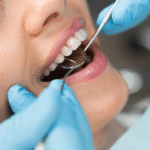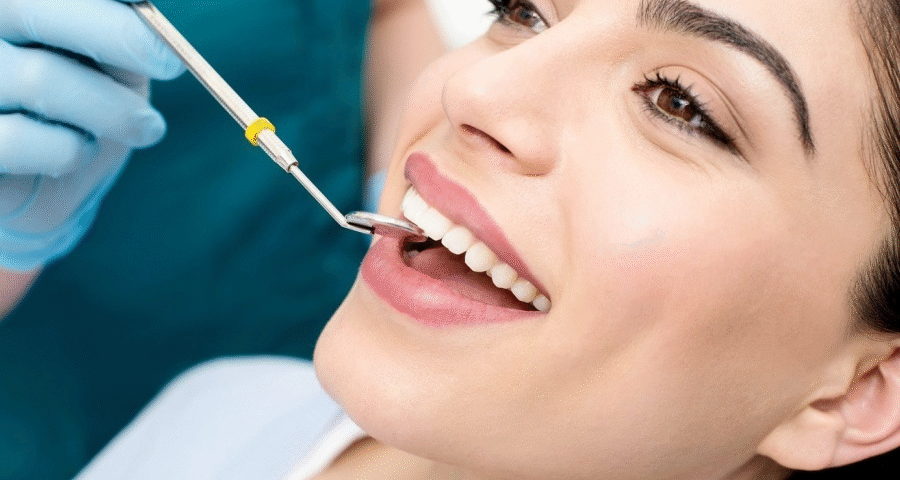
When to Visit a Chiropractor for Posture Correction
September 26, 2025
Dentistry Treatments for Cavities and Gum Disease
September 26, 2025
A beautiful smile is more than just an aesthetic feature—it’s often the first thing people notice about you. Smiling with confidence can boost self-esteem, improve social interactions, and even open doors in your personal and professional life. But not everyone is born with a perfect set of teeth, and that’s where cosmetic dentistry solutions for smile improvement come into play.
Cosmetic dentistry has come a long way over the years. Today, it offers a wide range of treatments designed to correct imperfections, brighten your teeth, and enhance the overall appearance of your smile. Whether you’re dealing with chipped teeth, stains, gaps, or misalignment, there’s a solution that can help.
In this article, we’ll explore the most effective cosmetic dentistry options, their benefits, and what you can expect from each procedure.
Understanding Cosmetic Dentistry
Cosmetic dentistry is a branch of dental care focused on improving the appearance of teeth, gums, and the overall smile. While some procedures also improve oral health, the primary goal is aesthetics. These treatments can be minor adjustments or full smile makeovers, depending on your needs.
The beauty of cosmetic dentistry is its versatility—it can be customized to your goals. Some people may only need teeth whitening, while others might require veneers or orthodontics to achieve their dream smile.
Popular Cosmetic Dentistry Solutions
1. Teeth Whitening
One of the most common and affordable cosmetic treatments is professional teeth whitening. Over time, teeth can become stained from coffee, tea, wine, smoking, or even just the natural aging process.
- In-office whitening: Performed by a dentist, this method uses stronger bleaching agents and can lighten teeth several shades in a single visit.
- At-home whitening kits: Custom trays and professional-grade gels provided by your dentist allow you to whiten your teeth gradually at home.
Benefits: Quick, safe, and effective results with little to no downtime.
2. Dental Veneers
Veneers are thin shells made of porcelain or composite resin that cover the front surface of teeth. They are ideal for correcting chipped, stained, or slightly crooked teeth.
- Porcelain veneers: Durable, natural-looking, and stain-resistant.
- Composite veneers: More affordable but may not last as long as porcelain.
Benefits: Provide a dramatic transformation and can last 10–15 years with proper care.
3. Dental Bonding
Bonding involves applying a tooth-colored resin to fix minor flaws such as chips, cracks, or small gaps. The material is shaped to blend naturally with the rest of your teeth.
Benefits: Less expensive than veneers, usually completed in one visit, and minimally invasive.
4. Orthodontics (Braces and Invisalign)
Crooked or misaligned teeth can make people self-conscious. Orthodontic solutions like traditional braces or Invisalign clear aligners gradually shift teeth into proper alignment.
- Braces: Effective for more complex issues but are more visible.
- Invisalign: Nearly invisible, removable aligners that are comfortable and discreet.
Benefits: Improved bite, better oral health, and long-lasting straight teeth.
5. Dental Implants
Missing teeth can impact both function and appearance. Dental implants are titanium posts surgically placed in the jawbone to act as artificial tooth roots. A crown is then attached to complete the look.
Benefits: Permanent, natural-looking, and improve both chewing ability and appearance.
6. Gum Contouring
Sometimes the problem isn’t your teeth—it’s your gums. A “gummy smile” can be corrected with gum contouring, where excess gum tissue is reshaped to reveal more of your teeth.
Benefits: Creates balance between gums and teeth for a more proportionate smile.
7. Smile Makeover
For those with multiple concerns, a smile makeover may be the best option. This customized treatment plan combines several procedures—such as whitening, veneers, and implants—to achieve your ideal smile.
Choosing the Right Solution for You
Not all cosmetic dentistry treatments are right for everyone. Factors such as oral health, budget, lifestyle, and long-term goals all play a role in deciding the best option.
Here’s a quick comparison to help you decide:
| Treatment | Best For | Longevity | Cost Range |
|---|---|---|---|
| Teeth Whitening | Stains, discoloration | 6–12 months | Low |
| Veneers | Stains, chips, gaps | 10–15 years | High |
| Bonding | Minor chips, cracks | 3–10 years | Low–Medium |
| Invisalign/Braces | Misalignment | Permanent (with retention) | Medium–High |
| Dental Implants | Missing teeth | 15+ years | High |
| Gum Contouring | Gummy smile | Permanent | Medium |
The Emotional Impact of Smile Improvement
Cosmetic dentistry isn’t just about looks—it can change how you feel about yourself. Many patients report:
- Increased confidence in social and professional situations
- A willingness to smile more often
- Better motivation to maintain oral hygiene
- Relief from embarrassment or self-consciousness
Maintaining Your New Smile
Once you invest in cosmetic dentistry, it’s important to maintain your results:
- Brush and floss daily
- Limit stain-causing foods and drinks
- Avoid smoking
- Visit your dentist regularly for cleanings and check-ups
- Use a nightguard if you grind your teeth
Conclusion
Your smile is one of your most powerful assets, and cosmetic dentistry makes it possible to enhance it in ways you never thought achievable. From simple whitening treatments to advanced solutions like implants or veneers, there’s a cosmetic dentistry option to fit almost every need and budget.
If you’re considering improving your smile, consult with a qualified cosmetic dentist. They can assess your situation, recommend the right treatments, and help you achieve a smile that reflects your true confidence and personality.
FAQs About Cosmetic Dentistry Solutions
1. Are cosmetic dentistry procedures painful?
Most cosmetic dentistry treatments are minimally invasive and involve little to no pain. For procedures like implants or gum contouring, dentists usually provide anesthesia to ensure comfort.
2. How much does cosmetic dentistry typically cost?
The cost varies widely depending on the procedure. Whitening may cost a few hundred dollars, while veneers or implants can cost thousands. Many dentists offer financing options.
3. How do I know if I’m a good candidate for cosmetic dentistry?
If you have healthy gums and teeth but are unhappy with your smile’s appearance, you’re likely a good candidate. Severe oral health issues should be treated first.
4. How long do results from cosmetic dentistry last?
This depends on the treatment. Whitening may last a year, while veneers, implants, and orthodontics can last decades with proper care.
5. Can cosmetic dentistry improve oral health too?
Yes, in many cases. For example, straightening teeth improves bite function and makes cleaning easier, while implants prevent bone loss after tooth loss.

